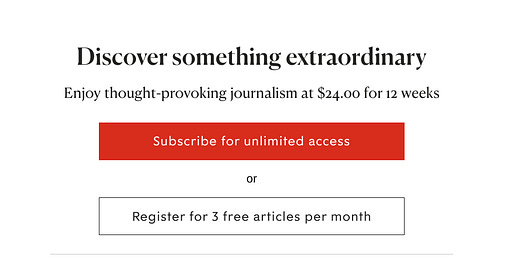The New Statesman’s newsletter strategy
Plus, Meta is planning to shut down Facebook News in the UK, France, and Germany.
Hi there,
Good morning! And welcome to Business Side.
Last month, we learned that The New Statesman is hosting all of its newsletters on Substack. It’s apparently the largest legacy publisher to do so.
The move is unconventional, especially for a UK political magazine founded in 1913. But the platform shift is only one part of a larger evolution in the publisher’s newsletter strategy.
Let’s look at their approach.
Streamlining the portfolio
This past May, The New Statesman made the decision to trim its newsletter portfolio down to two flagship products:
Morning Call (46k+ free subs): A daily, late-morning read on news and politics, featuring a mix of original New Statesman journalism and curated articles.
The Saturday Read (155k+ free subs): A weekly roundup of the best political & cultural writing, also featuring a mix of original and curated pieces.
The Morning Call has been around since 2016, but The Saturday Read was launched earlier this year, as a way to consolidate readership. The magazine’s head of newsletters Harry Lambert explained: “Instead of having a whole buffet of different newsletters and cutting the brilliance up into little segments, we just decided to give [the audience] one that we thought they’d like on Saturday and have the power of a big audience through one newsletter.”
Lambert sees this focused approach as a throwback to the constraints of print newspapers, with Morning Call serving as “your daily paper” and The Saturday Read as “your big Saturday paper.”
Converting free registrants to regular readers
Readers who want access to New Statesman journalism can either purchase a subscription or register to read three free articles per month. Here’s a screenshot from their article page:
Earlier this year, the outlet updated the flow so that all free registrants are auto-subscribed to The Saturday Read. The move has driven “a lot of the [newsletter’s] growth” and exposes new registrants to the Statesman’s best journalism without being “too intrusive.”
Driving paid subscriptions
The New Statesman monetizes its newsletters directly with advertising, but the outlet also wants to use the products to convert more paying subscribers.
Today, both The Saturday Read and Morning Call feature a red “Subscribe to the New Statesman” button that redirects to The New Statesman’s subscription landing page, which makes four interwoven appeals to potential subscribers:
Join a “community of free thinkers”
Support “110 years of independent journalism”
“Save money” compared to the newsstand price
Get “unlimited access to our progressive writing and analysis”
Going forward, the magazine is considering other ways to more tightly integrate newsletters into its subscription funnel. One idea is to launch a paid version of The Saturday Read, with the goal of attracting new readers at a price point below a full New Statesman subscription. According to Lambert, “The whole point of the newsletter was to engage people, and then hopefully encourage them to subscribe.”
To go deeper, read The Press Gazette profile.
And here’s the latest news in digital media:
Publishers:
Facebook referral traffic declined 40% in the first half of 2023, according to Chartbeat data.
NPR’s CEO John Lansing will retire at the end of this year.
Local news startup The Mill raised a £350k seed round from several prominent individuals, including new CNN chief Mark Thompson.
The Alden-owned MediaNews Group is buying four daily papers in Pennsylvania, including The Scranton Times-Tribune.
G/O Media shut down the Spanish-language version of Gizmodo.
The Guardian is also blocking OpenAI’s web crawler.
Platforms:
Meta is planning to shut down Facebook News in the UK, France, and Germany this December.
Meta is considering paid, ad-free versions of Facebook and Instagram for users in the EU.
Substack introduced AI audio transcription tools.
Threads is testing full-text search in Australia and New Zealand, while Instagram launched a “For you on Threads” carousel.
X updated its privacy policy so it can use public X data to train its AI models.
Interesting reads:
An excerpt from Walter Isaacson’s Elon Musk biography on the Twitter takeover.
An interview with event advisor Victoria Matey on what makes a great media event.
A deep dive into Spotify’s $1 billion bet on podcasting.
A New Yorker profile of new CNN CEO Mark Thompson.
A Nieman Lab profile of Pamplonews, a Pamplona-based newsletter distributed via WhatsApp.
Thanks for being a part of Business Side’s public beta. Have a great day!
Was this forwarded to you? Subscribe here.




